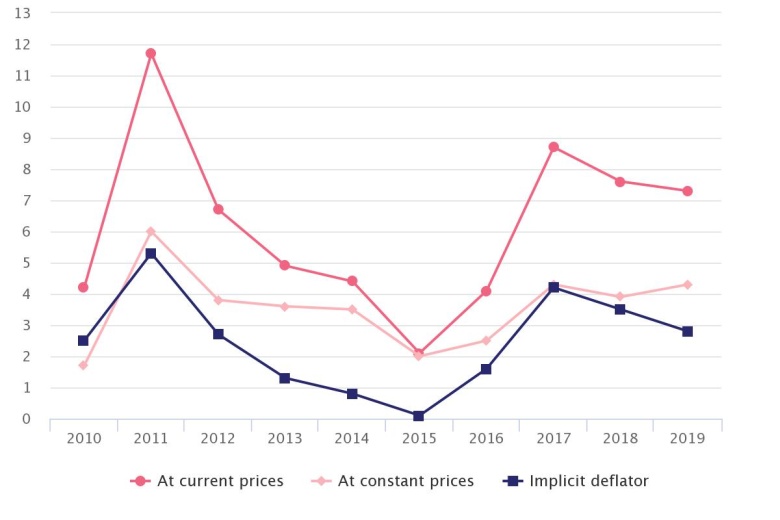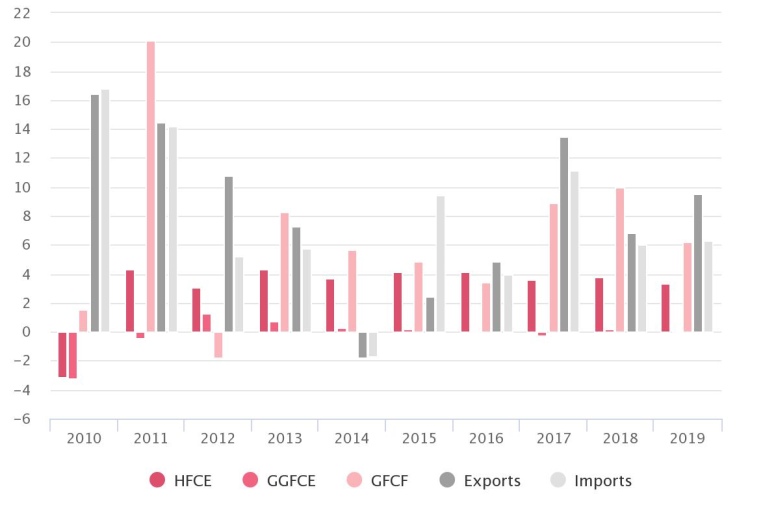Analytics, Economics, Financial Services, GDP, Lithuania, Markets and Companies
International Internet Magazine. Baltic States news & analytics
Sunday, 20.07.2025, 10:55
National accounts aggregates 2019 in Lithuania
 Print version
Print versionCompared to 2018, the real GDP change stood at 4.3%. The revised 2018 GDP amounted to EUR 45.5 billion, and compared to the previous period, grew by 3.9%. The previously published GDP change for 2019 was revised by 0.4 percentage points, for 2018 – 0.3 percentage points.

As for GDP estimated by production approach, aggregates at current prices, on production, intermediate consumption and gross value added (GVA) were revised for all economic activities by including into calculation the unpaid VATs due to insolvency of enterprises and by revising the estimates on housing rental services and fixed capital consumption. The 2018 aggregates were revised based on the final annual information of business statistics and administrative data sources, while the 2019 aggregates were estimated based on provisional annual sources of information. While performing annual estimations, deflators of certain areas are also revised, and this has had an impact on the growth rates.
The fast growth was recorded for GVA generated in enterprises engaged in construction (9.8 % in 2018 and 7.5 % in 2019), transportation and storage (6.9 and 9.8 % respectively), information and communication (7.9 and 7.8 % respectively), and administrative and support service activities (9.9 and 7.5 % respectively). A steady growth was also observed for the manufacturing as well as wholesale and retail trade enterprises having the highest relative weight in terms of GVA (respectively, 3.9 and 4.2 % in 2018; respectively, 4 and 2.9 % in 2019).
Compiling the expenditure components of GDP, changes were made for exports and imports of goods and services, household final consumption expenditure (HFCE) and gross fixed capital formation (GFCF). The revision of general government final consumption expenditure (GGFCE) is mainly related to the updating of fixed capital consumption and annual data sources.
From 2016, calculations include information covering transactions with non-residents related to the provision and consumption of television and radio broadcasting, telecommunications and electronic services. The remaining expenditure components have been revised insignificantly based on the latest information. The fast growth in 2018–2019 was recorded in GFCF (10 % and 6.2 %), exports (6.8 % and 9.5 %) and imports (6 % and 6.3 %) of goods and services, while moderate growth was observed for HFCE (3.7 % and 3.4 %).

As estimated by income approach, GDP components were revised insignificantly, and the changes were determined by the use of annual surveys and administrative data sources. Compensation of employees – an income component maintaining the fastest growth in 2018–2019 grew by 9.8 % and 10.8 % (at current prices). Taxes on production and products increased by 6.8 and 7.5 % respectively.
Revision of estimates of employment by national accounts categories was carried out, and the number of employed persons and hours worked were revised in accordance with information received on non-residents working in the country and time worked in secondary activities. In 2018 and 2019, the number of employed persons in the country increased by 1.4 and 0.5 % respectively, the number of employees – by 1.8 and 0.5 % respectively, while the number of self-employed persons decreased by 1.4 % in 2018 and increased by 0.2 % in 2019. As regards estimation of employment by hours worked, this indicator for employees increased (by 1.8 % in 2018 and 0.5 % in 2019), while for self-employed persons – decreased (by 0.9 and 0.3 % respectively).
Following the revision of GDP and employment, labour productivity was revised. In 2019, the GVA per person employed amounted to EUR 31.6 thousand, per hour worked – on average, EUR 16.8 at current prices. Labour productivity calculated based on the GVA per hour worked, compared to 2018, increased by 3.8 %. Estimates of growth rates of labour productivity based on the GVA at constant prices, in 2018, compared to 2017, the GVA per person employed increased by 2.1 %; in 2019, compared to 2018 – by 2.9 %.
In 2020, Statistics Lithuania carried out the second stage of the revision of the time series of the national accounts (NA). NA aggregates for 1995–2018 were revised following the introduction of new data sources and improvement of estimation methods, as well as taking into account the European Commission (EC) request provided after the gross national income (GNI) verification, and having harmonized the NA aggregates with the time series of government finance and balance of payments statistics.
More
information is available in Teminėse
lentelėse, Database
of Indicators.
Statistical
information is produced and disseminated pursuant to the European
Statistics Code of Practice.
For
more terms and explanations, please see the Dictionary
of Statistical Terms.
Employed population — persons doing any kind of work, for which they are remunerated in cash or in kind or have income or profit.
Labour productivity — an indicator expressed as a ratio of gross value added to the employed population or the number of hours worked.
Real GDP — gDP value, price change adjusted.
- 28.01.2022 BONO aims at a billion!
- 25.01.2021 Как банкиры 90-х делили «золотую милю» в Юрмале
- 30.12.2020 Накануне 25-летия Балтийский курс/The Baltic Course уходит с рынка деловых СМИ
- 30.12.2020 On the verge of its 25th anniversary, The Baltic Course leaves business media market
- 30.12.2020 EU to buy additional 100 mln doses of coronavirus vaccine
- 30.12.2020 ЕС закупит 100 млн. дополнительных доз вакцины Biontech и Pfizer
- 29.12.2020 В Латвии вводят комендантский час, ЧС продлена до 7 февраля
- 29.12.2020 В Rietumu и в этот раз создали особые праздничные открытки и календари 2021
- 29.12.2020 Latvia to impose curfew, state of emergency to be extended until February 7
- 29.12.2020 Linde Gas открывает завод в Кедайняйской СЭЗ








 «The Baltic Course» Is Sold and Stays in Business!
«The Baltic Course» Is Sold and Stays in Business!

